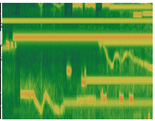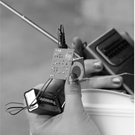Vickery, L. and James, S. (2019). Representations of Decay in the Works of Cat Hope, Tempo, 73(287) January 2019 , pp. 18-32.
This article considers the ‘representation of decay’ in selected concert works by the Australian composer Cat Hope. It draws on a mixed-method research methodology, comparing the conceptual aspects of Hope's oeuvre with analyses of studio and live recordings of Hope's work and discussing how such ideas of ‘decay’ may play out in the sonic world. Two forms of spectral analysis are employed: firstly the analysis of spectral parameters roughness, noisiness, brightness, pitch, and centroid, and secondly a visualisation of the music as a spectrogram. The data for the spectral analyses are derived from Alexander Harker's spectral descriptor tools for MaxMSP which record a value for each parameter every 25 milliseconds. At times, values are normalised within a range of 0 and 1, as representative of how listeners experience parametrical changes (i.e. dynamics, in relative terms rather than absolutes in relation to other sounds in the work). Importantly, perception of noisiness is more acute at frequencies in which the auditory critical bands are wider, below 250 Hz (roughly below middle C), precisely the upper range specified by Hope to define instruments suitable for the Australian Bass Orchestra.
|
| ||||||||



